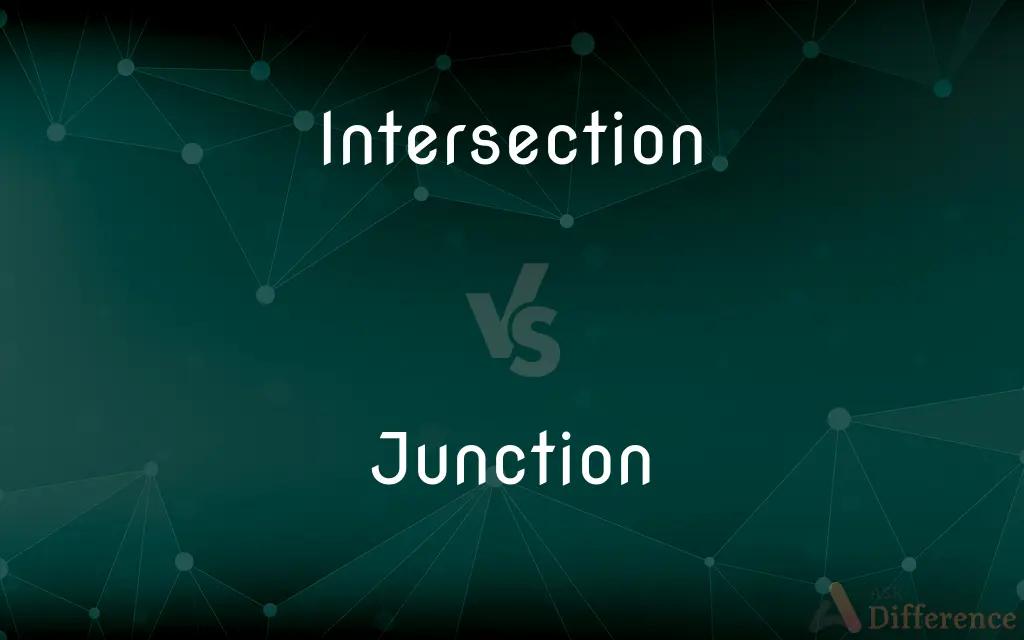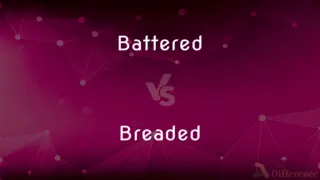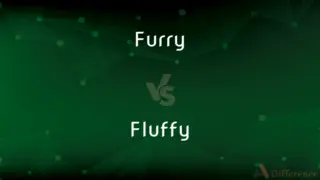Intersection vs. Junction — What's the Difference?
By Tayyaba Rehman & Maham Liaqat — Updated on March 7, 2024
Intersection is where roads meet at any angle, focusing on pedestrian and vehicle crossings; junctions are complex road connections, emphasizing direction changes without crossing paths.

Difference Between Intersection and Junction
Table of Contents
ADVERTISEMENT
Key Differences
Intersections are crucial points where two or more roads cross at any angle, allowing for the direct crossing of vehicles and pedestrians. They are characterized by their simpler designs and are often controlled by traffic signals, stop signs, or unregulated. On the other hand, junctions refer to places where roads or highways meet or join without necessarily crossing each other. They are designed to facilitate smooth transitions between different roads or highways, often involving ramps, roundabouts, or overpasses to manage traffic flow and minimize conflicts.
While intersections are primarily found in urban and residential areas, facilitating access and connectivity within cities, junctions are more common in highways or on the outskirts of urban areas, designed to handle high-speed traffic transitioning between different routes. Intersections focus on managing cross traffic, pedestrians, and local accessibility. In contrast, junctions prioritize maintaining traffic flow, minimizing stoppages, and enhancing safety at high speeds.
Intersections often require vehicles to stop or slow down significantly to navigate through, posing higher risks for accidents due to direct crossings. Junctions, however, are engineered to allow traffic to merge or diverge smoothly, usually without the need for stopping, thereby reducing the likelihood of collisions.
Design-wise, intersections are simpler, often consisting of a single level where roads directly cross each other. Junctions, conversely, may involve multi-level designs with bridges, tunnels, or flyovers, enabling different flows of traffic to bypass each other without interference.
In terms of traffic control, intersections frequently use traffic lights, stop signs, or yield signs to regulate traffic and ensure safety. Junctions, however, rely more on road design and less on traffic signals to manage the flow of vehicles, using signs for merging, exiting, and speed regulation instead.
ADVERTISEMENT
Comparison Chart
Definition
Point where roads cross at any angle.
Connection point of roads or highways without crossing.
Location
Urban and residential areas.
Highways or outskirts of urban areas.
Purpose
Facilitate direct crossing and local accessibility.
Ensure smooth transitions and maintain high-speed traffic flow.
Design
Simpler, often single-level crossings.
Complex, possibly multi-level with ramps or roundabouts.
Traffic Control
Traffic lights, stop signs.
Merging signs, less reliance on signals.
Compare with Definitions
Intersection
A point where two or more roads meet or cross each other.
The intersection of Main Street and First Avenue is known for its heavy traffic during rush hour.
Junction
Often located on highways or the outskirts of urban areas.
The junction outside the city connects multiple regional highways.
Intersection
Common in urban planning for cross traffic.
Pedestrian crosswalks are essential components of busy intersections.
Junction
Designed to minimize direct conflict points.
Overpasses at the junction allow traffic to merge safely at high speeds.
Intersection
Designed to manage direct traffic crossings.
The new intersection design includes bike lanes for safer cyclist passage.
Junction
May involve complex designs like ramps, roundabouts, or flyovers.
The flyover junction has greatly reduced travel time between the north and south sides of the city.
Intersection
Often equipped with traffic lights or stop signs.
The city installed traffic lights at the dangerous intersection to prevent accidents.
Junction
A place where roads or highways merge or diverge without crossing directly.
The newly constructed junction has significantly eased the traffic flow from the highway to the city.
Intersection
Primarily found within city limits or residential areas.
The intersection near the school has a crossing guard during opening and closing hours.
Junction
Facilitates smooth transitions between different roads or highways.
The roundabout at the junction reduces the need for traffic signals.
Intersection
In mathematics, the intersection of two or more objects is another, usually "smaller" object. Intuitively, the intersection of objects is that which belongs to all of them.
Junction
The act or process of joining or the condition of being joined.
Intersection
The act, process, or result of intersecting.
Junction
A place where two things join or meet, especially a place where two roads or railway routes come together and one terminates.
Intersection
A place where things intersect, especially a place where two or more roads cross.
Junction
A connection between conductors or sections of a transmission line.
Intersection
The point or locus of points where one line, surface, or solid crosses another.
Junction
The interface between two different semiconductor regions in a semiconductor device.
Intersection
A set that contains elements shared by two or more given sets.
Junction
A mechanical or alloyed contact between different metals or other materials, as in a thermocouple.
Intersection
The junction of two (or more) paths, streets, highways, or other thoroughfares.
Junction
The act of joining, or the state of being joined.
Intersection
Any overlap, confluence, or crossover.
Junction
A place where two things meet, especially where two roads meet.
Intersection
(geometry) The point or set of points common to two geometrical objects (such as the point where two lines meet or the line where two planes intersect).
Junction
The boundary between two physically different materials, especially between conductors, semiconductors, or metals.
Intersection
(set theory) The set containing all the elements that are common to two or more sets.
Junction
(nautical) The place where a distributary departs from the main stream.
Intersection
(sports) The element where two or more straight lines of synchronized skaters pass through each other.[http://www.isu.org/vsite/vcontent/content/transnews/0,10869,4844-128590-19728-18885-295370-3787-4771-layout160-129898-news-item,00.html]
Junction
(rail transport) A place where two or more railways or railroads meet.
Intersection
(category theory) The pullback of a corner of monics.
Junction
A point in time between two unrelated consecutive broadcasts.
Intersection
The act, state, or place of intersecting.
Junction
A kind of symbolic link to a directory.
Intersection
The point or line in which one line or surface cuts another.
Junction
(programming) In the Raku programming language, a construct representing a composite of several values connected by an operator.
Intersection
A point where lines intersect
Junction
(electronics) electrical junction: a point or area where multiple conductors or semiconductors make physical contact.
Intersection
A junction where one street or road crosses another
Junction
(of roads or tracks) To form a junction.
Intersection
A point or set of points common to two or more geometric configurations
Junction
The act of joining, or the state of being joined; union; combination; coalition; as, the junction of two armies or detachments; the junction of paths.
Intersection
The set of elements common to two or more sets;
The set of red hats is the intersection of the set of hats and the set of red things
Junction
The place or point of union, meeting, or junction; specifically, the place where two or more lines of railway meet or cross.
Intersection
A representation of common ground between theories or phenomena;
There was no overlap between their proposals
Junction
The place where two or more things come together
Intersection
The act of intersecting (as joining by causing your path to intersect your target's path)
Junction
The state of being joined together
Junction
The shape or manner in which things come together and a connection is made
Junction
Something that joins or connects
Junction
An act of joining or adjoining things
Common Curiosities
How do intersections and junctions differ in design?
Intersections have simpler designs for direct crossings, whereas junctions may have complex multi-level designs for smooth traffic flow.
What is an intersection?
An intersection is a point where two or more roads cross each other, allowing for direct traffic and pedestrian crossings.
What is a junction?
A junction is a connection point between roads or highways, designed to facilitate smooth transitions without direct crossings.
How does traffic control differ between intersections and junctions?
Intersections often use traffic lights and stop signs, while junctions rely more on road design and signs for merging and speed regulation.
Where are junctions more likely to be located?
Junctions are typically located on highways or at the outskirts of urban areas.
What is the main purpose of an intersection?
The main purpose of an intersection is to facilitate direct crossing and access within cities.
What is the primary function of a junction?
The primary function of a junction is to ensure smooth transitions and maintain high-speed traffic flow between different routes.
Can intersections be found on highways?
While intersections can occur on highways, they are more commonly replaced by junctions to maintain traffic flow.
What safety measures are common at intersections?
Common safety measures at intersections include traffic lights, stop signs, and pedestrian crosswalks.
Where are intersections commonly found?
Intersections are commonly found in urban and residential areas.
How do junctions handle high-speed traffic?
Junctions handle high-speed traffic through designs that allow vehicles to merge, exit, or change routes smoothly without significant speed reduction.
Are junctions safer than intersections?
Junctions are generally considered safer than intersections due to their design minimizing direct conflict points and maintaining smooth traffic flow.
Can junctions include roundabouts?
Yes, junctions can include roundabouts to facilitate traffic merging and diverging without the need for traffic lights.
What role do flyovers play in junctions?
Flyovers in junctions allow traffic to bypass intersections or merge without interfering with other traffic flows, enhancing safety and efficiency.
Do all intersections have traffic lights?
Not all intersections have traffic lights; some may be controlled by stop signs or be unregulated, depending on traffic volume and location.
Share Your Discovery

Previous Comparison
Battered vs. Breaded
Next Comparison
Furry vs. FluffyAuthor Spotlight
Written by
Tayyaba RehmanTayyaba Rehman is a distinguished writer, currently serving as a primary contributor to askdifference.com. As a researcher in semantics and etymology, Tayyaba's passion for the complexity of languages and their distinctions has found a perfect home on the platform. Tayyaba delves into the intricacies of language, distinguishing between commonly confused words and phrases, thereby providing clarity for readers worldwide.
Co-written by
Maham Liaqat












































